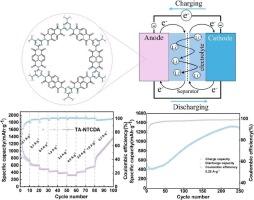具有双氧化还原活性中心的聚酰亚胺基共价有机骨架作为锂离子电池的高性能阳极
IF 8.9
2区 工程技术
Q1 ENERGY & FUELS
引用次数: 0
摘要
有机材料因其高容量、可持续性和分子可调性而成为锂离子电池的新兴电极材料。然而,它们的商业应用面临着诸如导电性不足和在有机电解质中的潜在溶解等瓶颈。本文以三聚氰胺和1,4,5,8-萘四羧酸为单体,合成了含有双氧化还原活性位点的聚酰亚胺基共价有机骨架(TA-NTCDA)。TA-NTCDA的π共轭结构不仅能加速电荷转移,还能抑制其在有机电解质中的溶解。TA-NTCDA中丰富的羰基和三嗪基单元为锂离子的去离子/插层提供了大量的活性位点,可以有效地提高理论比容量。作为锂离子电池的阳极,TA-NTCDA在0.25 a·g−1电流密度下,循环250次后的比容量为1283 mAh·g−1,具有高容量和长循环稳定性。即使在2.5 a·g−1的高电流密度下,TA-NTCDA电极仍表现出优异的稳定性。在300次循环后,其容量达到860 mAh·g−1的峰值,在600次循环后仍能保持634 mAh·g−1的高水平。此外,理论计算揭示了TA-NTCDA作为阳极材料的适用性以及不同活性位点对锂离子的结合能力。本研究为高性能聚酰亚胺基电极材料的设计提供了一种有效的策略。本文章由计算机程序翻译,如有差异,请以英文原文为准。

Polyimide-based covalent organic frameworks with dual redox-active centers as a high-performance anode for lithium-ion batteries
Organic materials have become emerging electrode materials for lithium-ion batteries due to their high capacity, sustainability and molecular tunability. However, their commercial application faces bottlenecks such as insufficient conductivity and potential dissolution in organic electrolytes. Here, a polyimide-based covalent organic framework (TA-NTCDA) containing dual-redox active sites was synthesized by using melamine and 1,4,5,8-naphthalenetetracarboxylic anhydride as monomers. The π-conjugated structure of TA-NTCDA not only accelerates charge transfer, but also inhibits its dissolution in organic electrolytes. The abundant carbonyl and triazine units in TA-NTCDA provide a large number of active sites for the deionization/intercalation of lithium ions, which can effectively increase the theoretical specific capacity. As the anode of lithium-ion batteries, TA-NTCDA demonstrated high capacity and long cycle stability, with a specific capacity of 1283 mAh·g−1 after 250 cycles at a current density of 0.25 A·g−1. Even at a high current density of 2.5 A·g−1, the TA-NTCDA electrode still exhibited excellent stability. Its capacity reached a peak of 860 mAh·g−1 after 300 cycles and was still able to maintain a high level of 634 mAh·g−1 after 600 cycles. In addition, theoretical calculations revealed the applicability of TA-NTCDA as an anode material and the binding ability of different active sites to lithium ions. This study provides an effective strategy for the design of high-performance polyimide-based electrode materials.
求助全文
通过发布文献求助,成功后即可免费获取论文全文。
去求助
来源期刊

Journal of energy storage
Energy-Renewable Energy, Sustainability and the Environment
CiteScore
11.80
自引率
24.50%
发文量
2262
审稿时长
69 days
期刊介绍:
Journal of energy storage focusses on all aspects of energy storage, in particular systems integration, electric grid integration, modelling and analysis, novel energy storage technologies, sizing and management strategies, business models for operation of storage systems and energy storage developments worldwide.
 求助内容:
求助内容: 应助结果提醒方式:
应助结果提醒方式:


